Since summer is the only time that this adventure can reasonably be accomplished, we thought we would take a look back at one of the most interesting days we have ever spent.

Since the day our youngest, The Boy, took a job as a pilot in Alaska we have been intrigued by the unique corner of Alaska that his small airline, Yute Air, serves.
Yute flies to about two dozen little native villages from their base in the town of Bethel which, with only five thousand residents, is not much more than a village itself.

Being certain that we wanted to see our son’s new life firsthand, he was just as certain that we we wouldn’t be able to handle the extreme cold and dark of an arctic winter.
So we patiently waited for warmer weather to head up to the Last Frontier for a visit.
After spending a few days with him in and around Anchorage, we felt were ready to tackle the tundra.
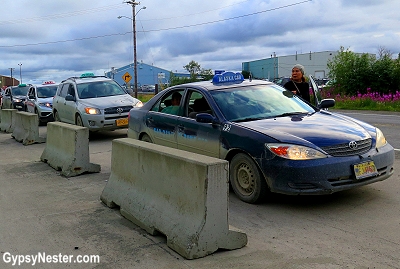
Bethel has no roads leading in or out of it — the harsh landscape is too prohibitive — so supplies and people come via jet service from Anchorage several times a day.
Much of that service is cargo that then is distributed to the tiny villages throughout the southwestern quadrant of the state by pilots like The Boy.

We arrived on the last flight of the day and met up with our son just as he was finishing his runs.
Since it was summer, and never got dark, we walked around town for awhile, and stopped for a pizza at one of the few food establishments.
It was then that we learned that even pizza is delivered by air in these parts!
Even in July, it was pretty chilly – we could only imagine what it’s like when December rolls around.
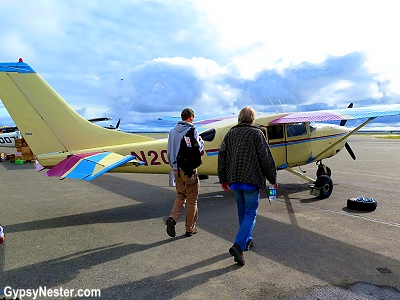
In the morning we booked a flight out to the westernmost, and largest, village that the airline serves, Toksook Bay.
This not only ensured that we would see the most scenery as possible; it also meant that we would be stopping in a couple of other villages along the way.
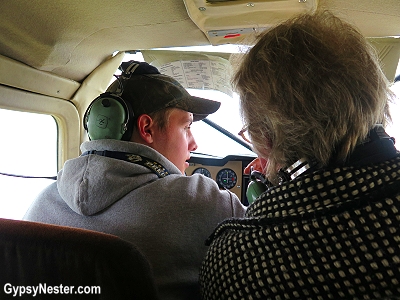
These are some of the most remote settlements anywhere in the United States.
They are completely isolated; the only way to reach them is by airplane, or sometimes boats, during the summer months.
In winter, dog sleds and snow machines can make it across the frozen marshland, but these are only practical for fairly short distances.

This means that the mail, and almost everything else that is delivered to the villages, arrives on these small aircraft.
They are truly their lifeline to the rest of the world.

After flying for nearly an hour over the soggy swampland that is the tundra when the frost has melted, we saw a small gravel landing strip perched on a slight rise above the mushy ground around it.
The Boy guided us in for a landing in Newtok and we unloaded a few supplies.

Sadly, this little settlement of about 350 people might not be around much longer.
The Ninglick River is eating away at the land, and with the permafrost melting due to warming temperatures, the village is sinking below sea level.
The elders are looking into possible relocation of the entire town.

With a little less cargo, but a new passenger aboard, we took off for our next stop, Tununak.
This lonesome outpost sits on the northwest coast of America’s fifteenth largest island, Nelson Island.
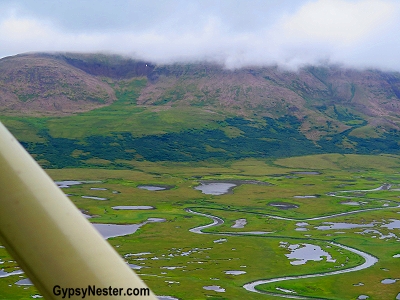
Aside from its size, the island named after nineteenth century naturalist Edward Nelson is also known for its musk ox.
After being hunted to extinction on the island in the last century, the animals have been reintroduced and are beginning to make a comeback.


On our way from Tununak to Nunakauyak, or Toksook Bay, we spotted a couple of the hairy musk ox grazing on the hills.
Since we were flying low to stay beneath the clouds, The Boy took us over them for a closer look.
Then we turned out over the Bering Sea and lined up for our landing.


We were met at the airport, which consists of a gravel runway and one small shed, by Melvin, who works as the agent for Yute Air.
He had agreed to show us around, so we climbed aboard his ATV four-wheeler, which serve as the preferred mode of transportation in the village (no roads out, who needs a car?), and bounced down into the town as The Boy flew off to his next destination.
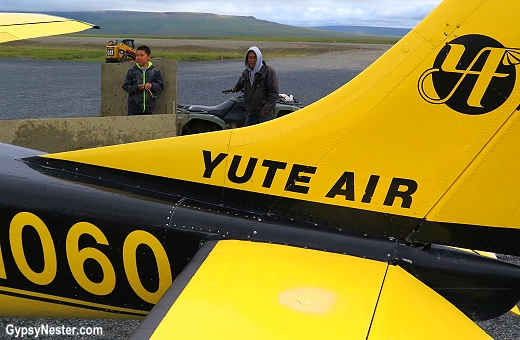

Almost all of the nearly six hundred residents of Toksook Bay — as well as this entire area of Alaska — are Yup’ik people, and they continue to live a lifestyle with traditions that have remained unchanged for centuries.
Hunting, fishing, and gathering are still primary sources of sustenance and folks still use many of the same tools that they have for generations, such as fish drying racks, and harpoons.

|
Little brother shows us his slingshot prowess and can already catch fish with his hands – great skills to have!! |
Our first stop made this clear, we went down by the water to the area where Melvin’s family, along with many others, smoke and dry the fish they catch.
He also showed us photographs of how he and his family hunt walrus. This hunting is allowed by the state under Alaskan laws written for the “preservation of historic or traditional Alaskan cultural practices” of her native peoples. |



Each of the villages we visited has a school, a post office, a clinic, and a small store.
We passed by all four on our tour, and Melvin was especially proud of his high school basketball program’s three straight trips to the state championship tournament.

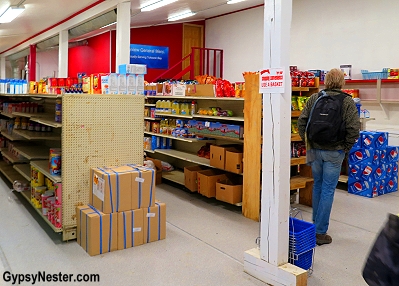
We were getting a little hungry, and there are no restaurants in Toksook Bay (we should have thought ahead a bit – oops), so we stopped in at the store to find something for lunch.
The first thing to strike us was the prices, most of them were crazy high.

When everything has to be flown in it is definitely reflected on the price tags.
We saw a package of spaghetti for $10.49, a can of soup for $5.89, six rolls of generic toilet paper for $8.99, cheese for $14.55, and a bag of Doritos for $8.29.
Holy crap – we’d be hunting, fishing, and gathering too!
The selection was a bit limited too, so the best we could come up with was deviled ham and wheat thins. We ate it sitting on the steps in front of the shop.

After our al fresco dining experience, the need for a restroom break earned us a trip to the town jail. It turned out to be the only public building open on a Sunday afternoon.

In fact, Melvin explained that it is always left open so that people can self-incarcerate should they feel that they have strayed outside of the rules laid out by the village council.
As the day went on it began to get colder, and a bit dreary. This was a mid-July afternoon and the temperature was rapidly dropping into the forties.
This definitely got our attention while riding on the four wheeler.

Seeing that we were getting chilled, Melvin offered to have us stop by his house for a visit. We were more than happy to accept his gracious invitation.

Inside we met four generations of his family.
His mother and grandmother were busy with babies, while his wife was whipping up something in the kitchen.
Earlier Melvin had pointed out people gathering salmonberries in the fields around town, and now we were about to try them.

We were unfamiliar with salmonberries, but upon seeing them, we recognized them as similar to cloudberries which we had sampled in Newfoundland.
One of the most common ways to eat them in Alaska is in a dish called Akutaq, or as Melvin called it, Eskimo ice cream.

The berries are mixed with whipped fat, traditionally from reindeer, moose, caribou, walrus, or often seal oil, but more recently Crisco has become the lubricant of choice, and a little sugar and milk is added.
We were served small bowls before we knew the ingredients, and while not blown away – or nearly as excited about it as the kids were — we loved the opportunity to try the unique treat.

Melvin also wanted to make sure that we tried some of the dried salmon that had been on the racks we saw earlier.
Now this was more up our alley, smoky and salty, it tasted like jerky – delicious.
Plus we were still a little peckish from our light lunch.

While we were chatting, a young man carrying a package came through the door.
This meant it was time for Melvin to put back on his airline agent hat, and for us to catch a ride with him back to the airport.

In a few minutes we heard the drone of an approaching Cessna, so we said our thanks and good-byes to Melvin.


We took off again, this time without The Boy. Another pilot, Buggy, was at the helm.
He is a long time veteran of Yute Air, and also a Yup’ik, so he knows this area like the back of his hand.
We were joined by another passenger, which meant that we would make a stop in one more village, Chefornak, on our way.

By the time we returned to Bethel we had compiled ten takeoffs and landings on the day – but we weren’t through just yet.
We still had three more flights ahead of us to get back down to, and across the lower forty-eight.
That meant that by the time we were finished we had been through sixteen takeoffs and landings in one twenty-four hour span.
We also traveled from the very western edge of North America to the East coast and from one of America’s smallest villages to New York City.
Yikes, most flight crews have never even done that!
David & Veronica, GypsyNester.com
See all of our adventures in Alaska!
YOUR TURN: Have you visited a truly remote part of the world? Would you fly in a tiny plane over the tundra? Wasn’t Melvin great to show us around his village home?



Dear Veronica, what a fabulous story and experience. Can you share with us how you set up the trip through Yute Air, and what it cost for the two of you? We hope to be in Alaska from late June through September, and plan to fly over Gates of the Arctic but know it will not satisfy our urge to see more of Alaska’s wilderness and tribal communities. Is it feasible for people who do not have a son piloting the aircraft? Please advise!! PS we hope to have both vaccine doses done by departure to Alaska!! If not, we will not be going.
Hi Jill. A couple points to make. First, Yute Air went out of business so obviously our son doesn’t fly for them anymore. I hate to say it but I don’t know what the cost would have been for our trip since the company comped it for us. But there are many small airlines up there that could probably meet your needs. I do think you would need to have your vaccines and proof of them as well.
This was a great story and I loved reading it. Your son really travels an interesting path and as a mom, I can certainly understand the worry, but also the joy of knowing that he is doing what he loves! Looking forward to reading more tales of his/your travels. 🙂
Thanks Patti. He loves it up there.
16 take offs and landings in one day would be a serious test for me. Our record was 12, but that was over 3 weeks—-and they were all jets. When is the Boy’s book being published? He’s certainly having different experiences than most of his peers.
It was crazy! Don’t think he’ll be finding time to write a book any time soon. Too bad, he’s got some stories, that’s for sure.
Wow! What an adventure. Very interesting information on Alaska!
Thanks for sharing my hometown area. It was a pleasure flying with you guys. it felt like the James’ family flying from Newtok to Tununak. Didn’t know your last name was James too. I was sitting next to you Veronica. Enjoy as I will with my wonderful the James’ family in Tununak:)
Hello James, yes we remember flying with you and talking. So glad to hear from you. We really enjoyed visiting your part of the world.
I love it! Yute Air is their bus line. So fascinating to get to these remote places. I tried cloudberries in Norway; am definitely not a fan. Interesting on the grocery prices. Trying to duplicate a lower 48 lifestyle in these places is a definitely a losing proposition.
I can tell you that mixing in Crisco did not help our feelings about the cloudberries.
Great photos and journaling. I flew out of Bethel in the 90’s as a bush pilot for Grant Aviation, among others.
Your vivid pictures have whisked me back to my fond Tundra memories.
Great photography! Thank you for reminding me about the intricacies of village life. I miss the Yu’pik and wildlife, but not the mosquitos…
Cheers
Thanks! It is definitely a different world up there. We loved it (wouldn’t want to live there) and our son is still up there, in Anchorage now but flies out of Prince of Wales Island.
I hope I get to fly Yute air when I visit Alaska. Some of these photos are gorgeous.
The apple doesn’t fall far from the tree. Sounds like your son shares your moxie and joy de vivre!
He certainly does.
I taught in Toksook Bay for 6 years. It was a great place to live. The first year I was by my self. The next 5 I had my grandson with me. He was 2 when he first came to the village. We were welcomed with open arms. It was a great experience for both of us. I have thousands of pictures if you would like some.
It must have been quite an interesting experience Julie. I think that I would have a very hard time with the winters though. Thanks for the offer, I took at least a thousand myself.
I am green with envy. It just sounds so interesting. I know a little about remote living having lived on a small island in the middle of the Pacific Ocean once. Google ‘Norfolk Island’ if you want to know about remote. There wasn’t a port so everything either came by air or had to be brought in by ‘lighters’ from a supply ship as it stood way of the coast. It meant that prices were hideous but also that so many of the things we take for granted were just unavailable. I learnt to cook the most basic things which now I just pop down the supermarket for. It was quite an experience and I would love to go back just for a visit. I wouldn’t want to live there again though.
Wow, that does sound remote! Have to agree, glad we visited but wouldn’t want to live there – we don’t have the skill set! 😉
How fabulous to have been able to join your son and see the remote Tundra villages that he flies to….so remote and so isolated. I wonder what that pizza delivery costs!
The Boy told us it usually runs about $50. You really have to want a pizza!
I think the remotest place I’ve ever been was in a rainforest on a mountain in the north of Malawi. I’d love to see such a remote town in Alaska, except that those little planes scare me! But I have questions: do they fly in the winter too, and just keep clearing the gravel runways? And how do they get really big things like cars to Bethel? Can really big cargo planes fly there?
Yes they fly year round. The area doesn’t really get that much snow, just incredibly cold. They shut down if it gets to -30 f, which happened several times last winter.
Bethel has a nice big paved runway that can handle any aircraft. It is the third busiest airport in Alaska. Also for a few months a year the river is passable for barges.
What an incredible job that your son has. I am pleased you were able to walk in his shoes for a while. I think I would love the extreme cold and dark of an arctic winter. Maybe.
I wouldn’t mind seeing it…. for a few days.
Excellent article. So accurate. Thanks for the visit to our part of the world
Andrew Flagg
Yute Air Station Manager
We were so glad to see and learn about your area, thanks Andrew.